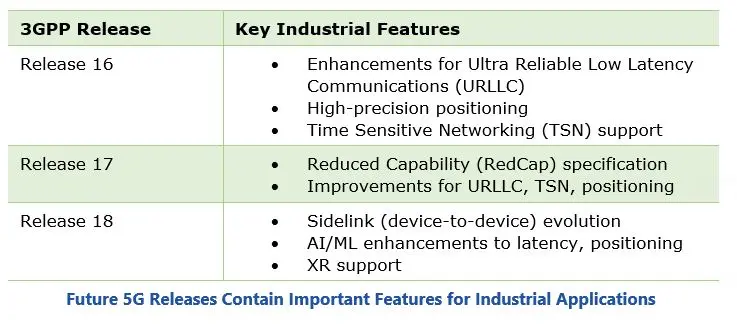

Keywords: Industrial 5G, Industrial Internet of Things (IoT), Industrial IoT Edge, Industrial Cellular Routers, 3GPP, Mobile Broadband Standards, Networking, URLLC, RedCap, ARC Advisory Group.
The continuous evolution of cellular technology is driving increased consideration of 5G as a primary communications medium versus its historical use for network backup and failover and offline remote access and monitoring.5G promises significant connectivity performance improvements that meet the growing needs of industrial IoT, Industry 4.0, edge computing, and autonomous operations strategies. The escalating bandwidth requirements inherent in these current and emerging use cases can be met by increasingly refined cellular technology.
However, delays in the release schedule of 5G updates suitable for industrial applications, a lag in availability of compatible hardware, and its high cost and complexity compared to alternative technologies have contributed to a prolonged adoption phase. Industry is awaiting features such as improved reliability, lower latency, and more precise positioning that are vital for mission-critical applications.
Many of the currently available industrial 5G devices are first generation, intended for pilot projects and small deployments, and provide only the base functionality of 5G as specified in 3GPP Release 15. The purpose of this report is to analyze the current and future prospects of industrial 5G adoption and evaluate the technology’s potential applications.

Presently, 5G technology holds immense potential in the industrial context, promising high bandwidth, low latency, and massive IoT device connectivity. These attractive features have generated a considerable amount of excitement in the industrial market, and suppliers are responding by investing in new product design and incorporating 5G into their portfolios. 5G itself is certainly powerful, but in the industrial realm, solutions are what drive the adoption of new technology.
Implementation of Industrial IoT and Industry 4.0 strategies have increased demand for connectivity solutions with substantial IoT device capacity and high bandwidth, including 5G. In smart manufacturing, for example, the deployment of a multitude of sensors and devices for real-time monitoring of machinery, predictive maintenance, and quality control relies on expansive device connectivity and high-speed data transfer capabilities. In logistics and smart warehouses, the tracking and coordination of numerous assets, some of which operate autonomously, benefit from the massive IoT device capacity and low-latency communication offered by 5G.
Industrial 5G is a powerful connectivity and data platform that can address the escalating data demands associated with AI and machine learning, edge computing, and analytics in industrial settings. The robust capabilities of 5G provide a foundation for facilitating seamless communication between an increasing number of devices and supporting the data-intensive requirements of advancing industrial technologies. As AI algorithms continue to evolve and demand real-time data inputs, industrial 5G can ensure the swift and reliable transfer of large datasets, including heavy image and video data. Support for ultra-reliable low latency communications (URLLC) will enhance this capability when the functionality is fully available in future 5G releases.
A strength of 5G is its capability to connect non-traditional assets that would prove challenging for wireline infrastructure or other wireless technologies. In the realm of mobile assets like vehicles, robots, and drones, 5G’s reliable uptime and low latency enable real-time data exchange crucial for navigation, coordination, and decision-making. In remote assets, including those dispersed over a wide area or in challenging industrial environments, 5G can facilitate efficient data transmission and control. These features position 5G as a transformative technology for connecting a diverse array of assets beyond the conventional scope, unlocking new possibilities for innovation and optimization in various industries.
ARC Advisory Group clients can view the complete report at the ARC Client Portal.
Please Contact Us if you would like to speak with the author.
Obtain more ARC In-depth Research at Market Analysis

